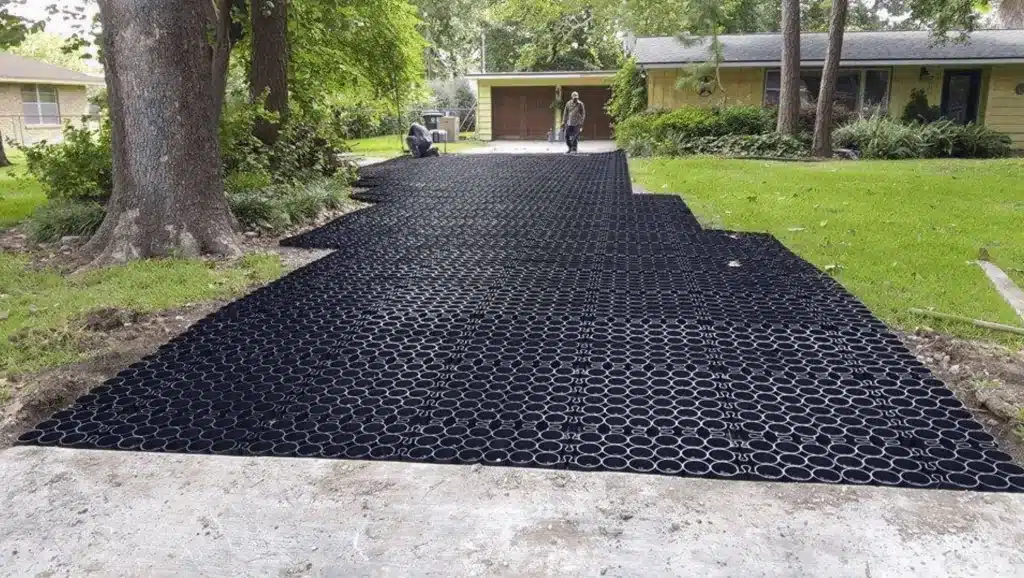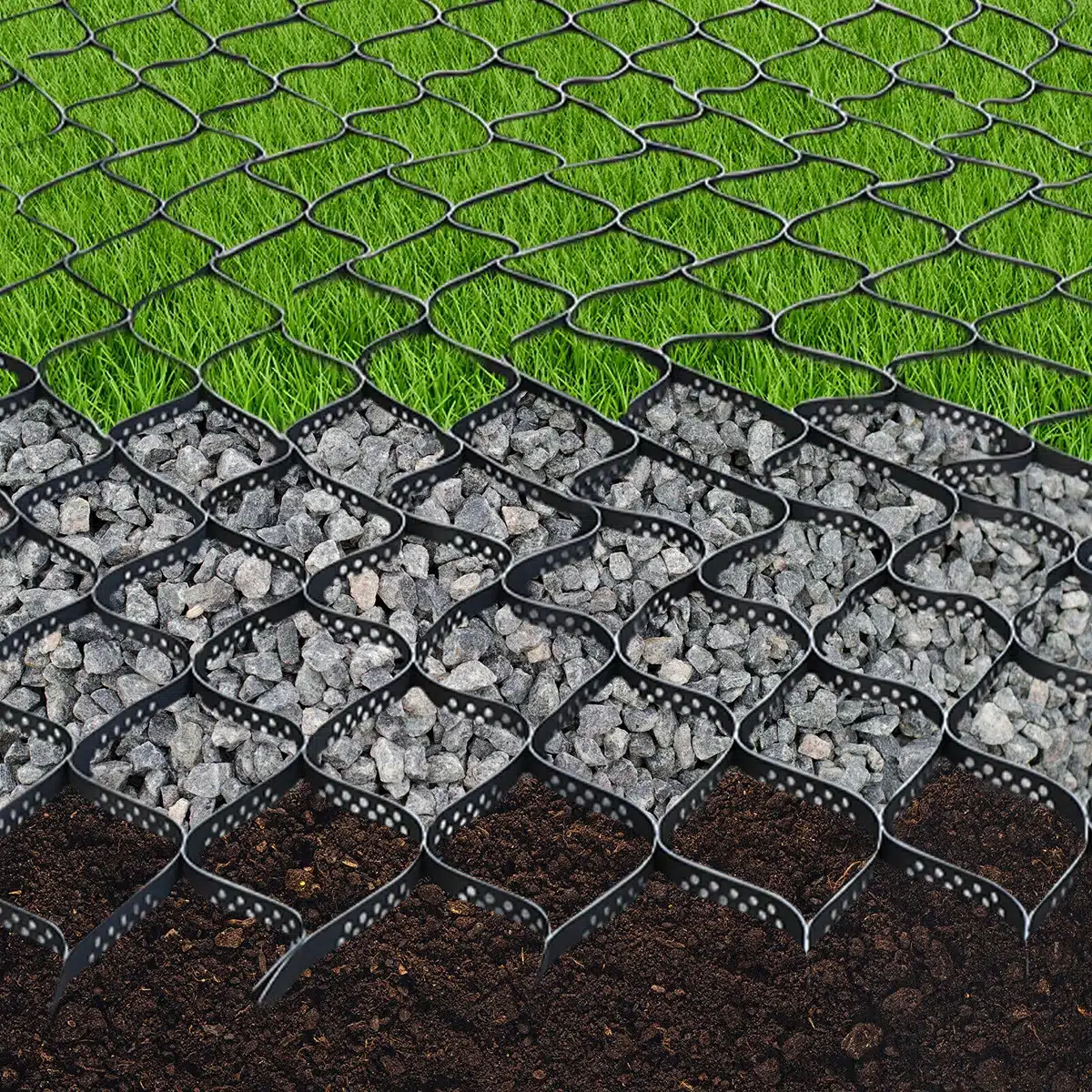+86-159 9860 6917
info@geofantex.com
geofantex@gmail.com
+86-400-8266163-44899
Designed for use on driveways and roadways, this material is the ideal product for reinforcing paved or gravel driveways.can help provide base reinforcement to a gravel driveway while reducing the amount of aggregate required.

Is Geogrid good for driveways?
Yes, geogrid is often a good choice for driveways. Here are some reasons why:
- Improved Load Distribution: Geogrids help to evenly distribute the weight of vehicles across the surface, reducing the risk of rutting and deformation.
- Enhanced Stability: By providing structural reinforcement, geogrids improve the overall stability of the driveway, making it more durable and resistant to heavy loads.
- Reduced Base Layer Thickness: Using geogrids can allow for a thinner base layer of aggregate, which can save on material costs without compromising the driveway’s strength.
- Erosion Control: Geogrids help to prevent soil erosion, which is particularly useful in areas with loose or unstable soils.
- Long-Term Performance: Driveways reinforced with geogrids tend to have a longer lifespan due to the added structural support, reducing maintenance needs and costs over time.
- Environmental Benefits: By reducing the amount of aggregate required, geogrids can also have a positive environmental impact by minimizing the material used and associated transportation emissions.
Overall, incorporating geogrid into driveway construction can enhance durability, stability, and cost-effectiveness.
Are driveway grids worth it?
Driveway grids, also known as grass grids, gravel grids, or permeable pavers, can be a worthwhile investment depending on your needs and circumstances. Here are some pros and cons to help you decide if they are right for you:
Eco-Friendly:
- Water Permeability: Driveway grids allow water to pass through, reducing runoff and promoting groundwater recharge. This helps mitigate flooding and reduces the burden on stormwater systems.
- Heat Reduction: Permeable surfaces tend to absorb less heat than traditional asphalt or concrete, helping to lower urban heat island effects.
Aesthetic Appeal:
- Natural Look: These grids can be filled with grass, gravel, or decorative stones, providing a more natural and visually appealing look compared to traditional driveways.
Durability:
- Load Bearing: High-quality grids can support the weight of vehicles, making them durable for regular use.
- Erosion Control: They help in stabilizing soil and preventing erosion.
Cost-Effectiveness:
- Long-Term Savings: While the initial cost may be higher than traditional paving, the longevity and reduced maintenance costs can make it more cost-effective in the long run.
Regulatory Compliance:
- Building Codes: In some areas, permeable surfaces are required to meet environmental regulations and zoning laws.
Initial Cost:
- Installation Expense: The upfront cost of materials and installation can be higher compared to traditional asphalt or concrete driveways.
Maintenance:
- Weed Control: Depending on the infill material, weeds may grow through the grids, requiring periodic maintenance.
- Cleaning: Gravel or other infill materials can become displaced and may need to be refilled or cleaned occasionally.
Installation Complexity:
- Professional Installation: Proper installation is crucial for the performance of driveway grids, often requiring professional services which can add to the cost.
Limited Use Cases:
- Heavy Loads: While they can support cars, driveway grids may not be suitable for very heavy vehicles or equipment.
Seasonal Considerations:
- Winter Challenges: In areas with heavy snowfall, clearing snow from a permeable surface can be more challenging than from a solid one.
Driveway grids are worth it if you value environmental benefits, aesthetic appeal, and long-term durability over the initial cost and potential maintenance efforts. They are particularly beneficial in areas with water runoff issues or where local regulations favor permeable surfaces. However, if you are concerned about initial expenses or maintenance, you may want to weigh these factors carefully before making a decision.
What is a geogrid driveway?
Definition and Purpose:
A geogrid driveway is a type of permeable driveway that uses a geogrid system to reinforce the ground. Geogrids are synthetic materials made from polymers, designed to provide structural stability and support to soil, gravel, or other materials.
Materials:
- Geogrid: Typically made from high-density polyethylene (HDPE) or polypropylene.
- Base Layer: Crushed stone or gravel.
- Fill Material: Gravel, crushed stone, or soil, often with grass or other vegetation planted within the grid cells.
Construction Process:
- Site Preparation: Clear and level the ground where the driveway will be constructed.
- Base Layer Installation: Spread and compact a layer of crushed stone or gravel to create a stable foundation.
- Geogrid Installation: Lay the geogrid panels over the base layer, ensuring they are properly aligned and secured.
- Filling: Fill the geogrid cells with gravel, crushed stone, or soil. If using soil, vegetation can be planted within the cells.
- Compaction and Finishing: Compact the filled material to ensure stability and create a smooth surface.
Benefits:
- Improved Drainage: The permeable structure allows water to pass through, reducing runoff and preventing erosion.
- Environmental Sustainability: Promotes groundwater recharge and can support plant growth.
- Durability and Strength: Provides enhanced load-bearing capacity, making it suitable for vehicular traffic.
- Reduced Maintenance: Minimizes issues like potholes and ruts common in traditional driveways.
Potential Drawbacks:
- Initial Cost: Higher upfront cost compared to traditional driveways due to materials and installation.
- Maintenance of Vegetation: If grass or other plants are used, they require regular maintenance.
- Not Suitable for All Climates: In regions with extreme weather conditions, such as heavy snowfall, the geogrid system may require additional maintenance or may not be as effective.
What is the best driveway material to stop weeds?
A geogrid driveway is a type of driveway reinforcement that uses a geogrid system to stabilize and support the surface. It is designed to provide a firm, durable foundation for driveways, preventing rutting and erosion and improving load distribution.
Purpose
The primary purpose of a geogrid driveway is to:
- Enhance the structural integrity of the driveway.
- Prevent sinking and rutting under heavy loads.
- Improve drainage and reduce surface water runoff.
- Extend the lifespan of the driveway surface.
Materials Used
- Geogrid: A synthetic mesh made from materials like polyethylene or polypropylene, designed to interlock and provide reinforcement.
- Aggregate: Gravel or crushed stone that fills the geogrid cells and forms the base layer.
- Sub-base Material: Often sand or a similar material that lies beneath the geogrid to aid in leveling and drainage.
Installation Process
- Excavation: Remove the existing driveway surface and excavate to the required depth.
- Sub-base Preparation: Lay and compact the sub-base material to create a level foundation.
- Geogrid Placement: Unroll the geogrid over the prepared sub-base, ensuring it is flat and properly aligned.
- Filling: Fill the geogrid cells with aggregate, making sure it is evenly distributed and compacted.
- Top Layer: Apply the final surface layer, which could be gravel, asphalt, or another suitable material, depending on the desired finish.
Benefits
- Stability: Provides excellent load distribution, preventing uneven settling and rutting.
- Durability: Extends the life of the driveway by preventing structural damage.
- Drainage: Enhances water drainage, reducing the risk of water damage and erosion.
- Cost-Effective: Often more affordable than traditional driveway reinforcement methods.
- Eco-Friendly: Can use recycled materials and promote better water infiltration into the ground.
Potential Drawbacks
- Initial Cost: Higher upfront cost compared to traditional gravel driveways.
- Installation Complexity: Requires careful installation to ensure effectiveness, which might necessitate professional help.
- Maintenance: Though durable, it may still require periodic maintenance to keep the surface in good condition.

During construction, the geogrid is positioned beneath the gravel to restrict horizontal movement and provide long-term support for roads. Biaxial geogrid is often favored by homeowners and construction experts over other geogrid types due to its ability to offer strength in all lateral directions. By incorporating geogrid, the need for expensive maintenance is reduced, and the overall lifespan of the project is extended.
The geogrid is made from durable punched polypropylene plastic and can be easily rolled out for installation.



Get Free Sample
We’ll respond as soon as possible(within 12 hours)






















